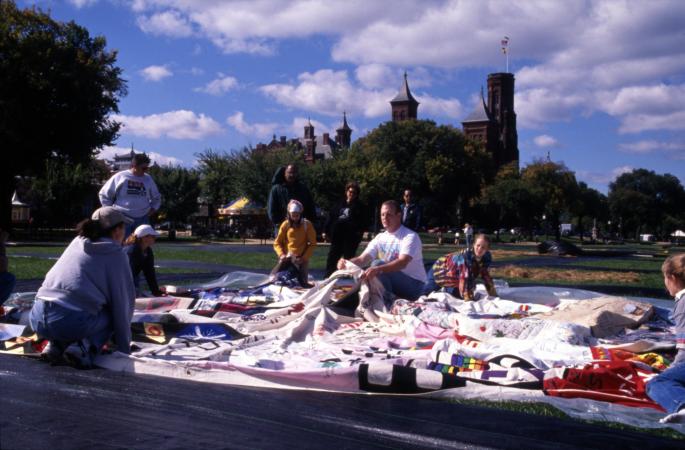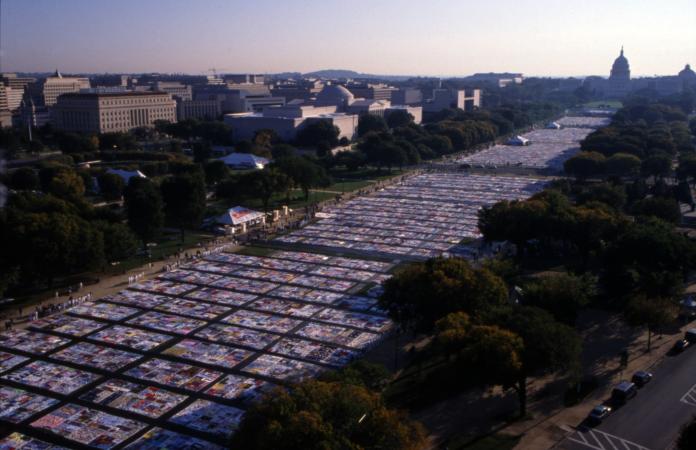On October 11, 1987, a team of 48 volunteers carefully unfolded 1,920 panels of the AIDS Memorial Quilt on the National Mall. Displayed in sections, the quilt covered more ground than a football field. On each of the panels were names of those who died of AIDS.
San Franciscan gay rights activist Cleve Jones and his friends first envisioned the idea for the quilt in 1985 when they put together a memorial by writing the names of lost loved ones on paper placards. Inspired by the project, they founded the NAMES Project Foundation to create a more enduring memorial with textile arts. Families and friends have continued this tradition of crafting quilt panels in honor of their loved ones who died in the AIDS epidemic.

The NAMES Project Foundation displayed the quilt during the 1987 National March for Gay and Lesbian Lives, where it emphasized the loss suffered by the LGBTQIA+ community in the AIDS epidemic. Over half a million visitors walked amongst the panels and listened as organizers read aloud each name included in the quilt in a tradition that has continued at nearly every display since. The display on a national setting offered a devastating visual representation of the human loss and highlighted the necessity of a response to the AIDS epidemic.

This first appearance in 1987 kicked off the quilt’s long history with the National Mall. It toured 20 cities in 1988, acquiring local panels and raising half a million dollars for AIDS service organizations. When it returned to the Smithsonian’s front yard in October 1988, the quilt gained over six thousand more panels and displayed a total of 8,288 individual stories on the ellipse in front of the White House. By 1992, the quilt included 12,000 panels, at least one from every state as well as 28 different countries. In October 1996, the quilt was displayed in its entirety for the final time with 40,000 panels that covered the entire Mall and drew approximately 1.2 million visitors. The quilt continued to raise awareness of HIV/AIDS and gained national and international significance with each display on the National Mall.

For its 25th anniversary in 2012, the AIDS Memorial Quilt returned to D.C. during the Smithsonian Folklife Festival for a collaboration between the NAMES Project Foundation and the Smithsonian Center for Folklife and Cultural Heritage. In the year leading up to the festival, the Smithsonian partnered with the NAMES Project to display Roger Lyon’s panel in the National Museum of American History from June 2011 to February 2012. Lyons was a gay rights activist who died in 1984 after testifying before Congress for funds to combat the epidemic.

By 2012, the quilt was too large for its 48,000 panels to be shown all at once. Instead, Folklife Festival organizers rotated sections of 1,500 panels a day over the two-week period. The quilt reappeared later that month on the Mall and in 50 locations around the city for the 2012 International AIDS Conference. Inspired by the displays, Smithsonian staff and volunteers began working on a Smithsonian panel to add to the quilt. Upon completion in 2013, the panel measured 12x12 feet and featured the Smithsonian Castle with the names of loved ones and miniature quilt panels adorning the grass below.

Today, the quilt still collects panels memorializing loved ones and illustrates the real, human component of HIV/AIDS history. All 48,000 panels, including the Smithsonian’s 2012 Smithsonian Folklife Festival contribution, are accessible online at the AIDS Memorial Quilt Virtual Exhibit.
Related Resources
- "Collecting an Epidemic: The AIDS Memorial Quilt," O Say Can You See?, Smithsonian's National Museum of American History
- "The AIDS Quilt: A Memorial," by Deborah Kallman, O Say Can You See?, Smithsonian's National Museum of American History
- "Unfolding the AIDS Memorial Quilt at the Folklife Festival," by K. Annabelle Smith, Smithsonian Magazine
Produced by the Smithsonian Institution Archives. For copyright questions, please see the Terms of Use.

Leave a Comment